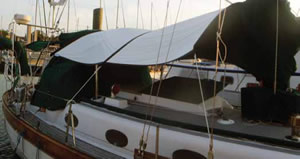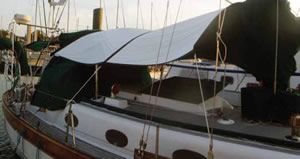Photos by Frank Lanier and courtesy of Crawford Boating Products

While everyone likes fun in the sun, theres nothing better than having it made in the shade-which is a precious commodity aboard a sailboat. At anchor, over-the-boom awnings provide both direct protection from the sun and cabin cooling by shading the deck and cabintop, significantly reducing temperatures down below. Most canvas shops can design and create custom awnings for a boat, but this route can be pricey in some markets. For those wanting to keep their cool without hiring a custom designer, other options include devising a homemade setup for next to nothing, or searching out a quality, pre-fabricated sailboat awning like the UltraShade reversible sun shade.
What We Tested
The UltraShade ($289) is a self-supporting, over-the-boom awning made by Crawford Boating Products, a small California-based company owned by brothers Andy and Tom Crawford. For support, the UltraShade employs three fiberglass tent-style poles. The awning material is TRP Ultrabounce, a lightweight nylon fabric (white on one side, black on the other) thats advertised as being UV resistant, tear resistant, waterproof, and machine washable.
Our fabric is what makes this awning unique, explained Andy Crawford. Its adapted from the motion picture-TV industry, where it is used to bounce light. With the white side up, it creates a very deep shade that is more effective at keeping an area cool than any other sunshade I have been under, and it cuts glare to a minimum. The fabric is ideal for this use because it is really tough and durable, waterproof (although when sewn, the seams will leak unless sealed), UV resistant, and very light weight.
Installing the UltraShade with the white side up reflects light and heat, while giving the cockpit glare-free shade. In cooler temps, having the black side up absorbs heat, while the white side (facing down) reflects light from underneath, providing a soft glow and warmth for evenings or rainy days.
The Field Test
Practical Sailor tested Crawfords standard-size UltraShade, which measures 9.5 feet by 8.5 feet, aboard a Union 36 sloop during a sunny summer cruise on the Chesapeake Bay. Although the standard UltraShade is designed as a small(er)-boat awning, testers reported that it would likely be a good size for most boats 20 to 35 feet long. We found the size to be adequate for the cockpit of our 36-foot test boat, however, its cockpit is admittedly smaller than some similar-sized boats of a more recent vintage and design. The UltraShade also worked well as a cover for the large butterfly hatch located in the main cabin.
Custom shapes, sizes, and lengths are available, but Crawford recommends keeping the beam measurement to 8.5 feet or less, simply because the company has never tested the fiberglass support poles in longer lengths, and hed like to make sure the awning would still be well-supported in the wind.
In tests, the well-constructed UltraShade held up well in 8 to 10 knots of breeze, and the covered-wagon shape kept rainwater from puddling as it would on a tarp. The Ultrabounce fabric is light weight and appears durable, although it is a new product, so only time will tell how its longevity compares to more well-known materials like Sunbrella and Weathermax (PS, December 2011 issue). Crawford offers no formal warranty but would consider any claims on a case-by-case basis.
The UltraShade comes with everything needed for installation except fore and aft lines, which are not provided due to the wide variances in boat lengths, tie down points, etc. The instructions are thorough and easy to follow, but even without them, setup is pretty intuitive. Once the lines were set, installing the awning took a single tester less than 5 minutes; it would be faster with two people, but solo setup is easy enough. Disassembled, the kit is compact and stores easily in the provided 6- by 30-inch cylindrical storage bag.
The UltraShade is comparable to or less than the cost of similar-sized prefabricated awnings. If the material holds up, it should serve well as a means of providing quick, easy shade.







































